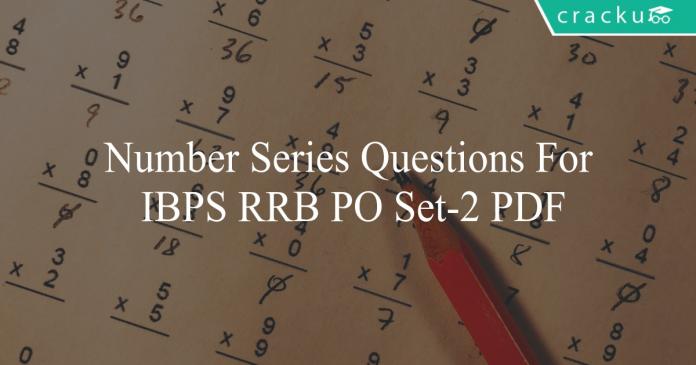Number Series Questions For IBPS RRB PO Set-2 PDF
Download Top-20 IBPS RRB PO Number Series Questions PDF. Number Series questions based on asked questions in previous year exam papers very important for the IBPS RRB PO (Officer Scale-I, II & III) exam
Download Number Series Questions For IBPS RRB PO Set-2 PDF
35 IBPS RRB PO Mocks @ Rs. 149. Enroll Now
70 IBPS RRB (PO + Clerk) Mocks @ Rs. 199
Take a free mock test for IBPS RRB PO
Download IBPS RRB PO Previous Papers PDF
Instructions
Select the option which replaces (?)
Question 1: 7, 11, 23, 51, 103, ?
a) 187
b) 193
c) 195
d) 185
e) 173
Question 2: 16, 23, 28, 38, ?, 62
a) 51
b) 47
c) 53
d) 45
e) 49
Question 3: 2, 6, 30, 60, 130, ?
a) 220
b) 210
c) 200
d) 190
e) 180
Question 4: 23, 39, 71, 119, ?
a) 192
b) 181
c) 174
d) 183
e) 185
Instructions
Find the next term in the series.
Question 5: 11, 26, 51, 76, 115, 174, ?
a) 245
b) 243
c) 217
d) 219
e) 231
Question 6: 221, 222, 223, 225, 228, 233, 241, 254, ?
a) 263
b) 296
c) 308
d) 275
e) 302
Free Mock Test for IBPS RRB PO
IBPS RRB Clerk Previous Papers
Question 7: 462, 506, 552, 600, 650, ?
a) 806
b) 718
c) 750
d) 812
e) 702
Question 8: 972, 648, 432, 288, ?
a) 186
b) 192
c) 212
d) 188
e) 200
Question 9: 17, 34, 31, 124, 119, 714, ?
a) 4284
b) 743
c) 707
d) 711
e) 728
Instructions
Identify the number which will replace the question mark (?).
Question 10: 11, 13, 16, 21, 28, 39, 52, ?
a) 89
b) 83
c) 69
d) 67
e) 72
Question 11: 23, 31, 29, 35, 35, 39?
a) 39
b) 44
c) 47
d) 41
e) 37
Question 12: 123, 124, 120, 129, 113, 138, ?
a) 102
b) 152
c) 172
d) 113
e) 165
Question 13: 67, 68, 76, ?, 167
a) 112
b) 103
c) 97
d) 107
e) 113
Question 14: 17, 25, 32, 37, ?, 58
a) 51
b) 47
c) 43
d) 49
e) 45
Instructions
Find the missing number in the series.
Question 15: 14, 30, 63, 130, 265, ?
a) 428
b) 447
c) 489
d) 536
e) 545
Quantitative Aptitude formulas PDF
520 Banking Mocks – Just Rs. 499
Question 16: 31, 44, 88, 176, 847, 1595, ?
a) 5586
b) 2534
c) 6537
d) 1892
e) 7546
Question 17: 2, 12, 36, 80, 150, ?
a) 212
b) 272
c) 252
d) 220
e) 290
Question 18: 13, 18, 25, 34, 45, ?
a) 58
b) 54
c) 67
d) 59
e) 65
Question 19: 113, 118, 128, 139, 152, ?
a) 172
b) 159
c) 166
d) 160
e) 162
Question 20: Select the option that logically continues the series:
-2, -3, 8, 95, ?
a) 673
b) 684
c) 691
d) 672
e) 671
18000 Free Solved Questions – Banking Study Material
35 IBPS RRB PO Mocks @ Rs. 149. Enroll Now
Answers & Solutions:
1) Answer (A)
Taking the difference of consecutive numbers, we have,
11 – 7 = 4
23 – 11 = 12
51 – 23 = 28
103-51 = 52
Takin difference of the difference of numbers, we have,
12- 4 =8
23-12 = 16
52-28 = 24
Accordingly, 52 + 32 = 84
So, the next number must be
103 + 84 = 187
Hence, option A is the right choice.
2) Answer (E)
16 + 1 +6 = 23
23 + 2 + 3 = 28
28 + 2 + 8 = 38
38 + 3 + 8 = 49
49 + 4+ 9 = 62
Hence, option E is the correct option.
3) Answer (B)
$1^3$ + 1 = 2
$2^3$ – 2 = 6
$3^3$ + 3 = 30
$4^3$ – 4 = 60
$5^3$ + 5 = 130
$6^3$ – 6 = 210
Hence, option B is the correct option.
4) Answer (D)
23+16 = 39
39 + 16*2 = 71
71 + 16*3 = 119
119 + 16*4 = 183
Hence, option D is the correct option.
5) Answer (C)
The continuous prime numbers are multiplied by 1, 2, 3 and so on
11
13 * 2 = 26
17 * 3 = 51
19 * 4 = 76
23 * 5 = 115
29 * 6 = 174
31 * 7 = 217
6) Answer (D)
The difference forms a Fibonacci series
1, 1, 2, 3, 5, 8, 13, 21
The series is:
221
221 + 1 = 222
222 + 1 = 223
223 + 2 = 225
225 + 3 = 228
228 + 5 = 233
233 + 8 = 241
241 + 13 = 254
254 + 21 = 275
Hence, 254 + 21 = 275 is the answer.
7) Answer (E)
The series follows the following pattern:
21 * 22 = 462
22* 23 = 506
23 * 24 = 552
24*25 = 600
25*26 = 650
26*27 = 702
8) Answer (B)
The series follows the following pattern:
972 * (2/3) = 648
648 * (2/3) = 432
432 * (2/3) = 288
288 * (2/3) = 192
9) Answer (C)
The series follows the following pattern:
17 * 2 = 34
34 – 3 = 31
31 * 4 = 124
124 – 5 = 119
119 * 6 = 714
714 – 7 = 707
10) Answer (C)
Consecutive prime numbers are being added in successive terms.
11 + 2 =13
13 + 3 = 16
16 + 5 = 21
21 + 7 = 28
28 + 11 = 39
39 + 13 = 52
Hence, the next term will be
52 + 17 = 69
11) Answer (D)
There are two series in the given set of numbers.
The numbers at odd places form 1 series which is given by
23, 29, 35
The numbers at the even places form the second sequence which is given by
31, 35, 39
Hence the next term would be 35+6 = 41
12) Answer (A)
The pattern being followed is
$ 123 + 1^{2} = 124$
$ 124 – 2^{2} = 120$
$ 120 + 3^{2} = 129$
$ 129 – 4^{2} = 113$
$ 113 + 5^{2} = 138$
$ 138 + 5^{2} = 138$
So the next term would be
$ 138 – 6^{2} = 102$
13) Answer (B)
The difference between the two consecutive terms is the cubes of natural numbers. For example
67+1 = 68
68+8 = 76
76 + 27 = 103
103 + 64 = 167
Hence, the missing term is 103
Thus, option B is the correct answer.
14) Answer (B)
The sum of the digits of the previous number is being added to the number to get the new number.
For example:
17 + 1 + 7 = 25
25 + 2 + 5 = 32
32 + 3 + 2 = 37
37 + 3 + 7 = 47
47 + 4 + 7 = 58
Hence, the missing number is 47.
15) Answer (D)
The series follows the following pattern:
14
14*2 + 2 = 30
30 * 2 + 3 = 63
63 * 2 + 4 = 130
130*2 + 5 = 265
265*2 + 6 = 536
16) Answer (E)
The series follows the following pattern:
31 + (13) = 44 (reverse of the number is added)
44 + 44 = 88
88 + 88 = 176
176 + 671 = 847
847 + 748 = 1595
1595 + 5951 = 7546
17) Answer (C)
The series follows the following pattern:
$1^2 + 1^3 = 2$
$ 2^2 + 2^3 = 12$
$ 3^2 + 3^3 = 36$
$4^2 + 4^3 = 80$
$5^2 + 5^3 = 150$
$6^2 + 6^3 = 252$
18) Answer (A)
The series follows the following pattern:
13 + 5 = 18
18 + 7 = 25
25 + 9 = 34
34 + 11 = 45
45 + 13 = 58
19) Answer (D)
The series follows the following pattern:
113
113 + (1 + 1 + 3) = 118
118 + (1 + 1 + 8) = 128
128 + (1 + 2 + 8) = 139
139 + (1 + 3 + 9) = 152
152 + ( 1 + 5 + 2) = 160
20) Answer (B)
The given numbers are of the form $n! – n^2$.
$2!-2^2$ = $2-4$=$-2$
$3!-3^2$ = $6-9$=$-3$
$4!-4^2$ = $24-16$=$8$
$5!-5^2$ = $120-25$=$95$
$6!-6^2$ = $720-36$=$684$
Therefore, option B is the right answer.




![IBPS PO Prelims Sentence Completion Questions [PDF]](https://cracku.in/blog/wp-content/uploads/2022/09/Sentence-Completion-Questions--218x150.png)
![IBPS PO Prelims Permutation and Combination Questions [PDF] _ Permutation and Combination Questions](https://cracku.in/blog/wp-content/uploads/2022/09/Permutation-and-Combination-Questions--218x150.png)